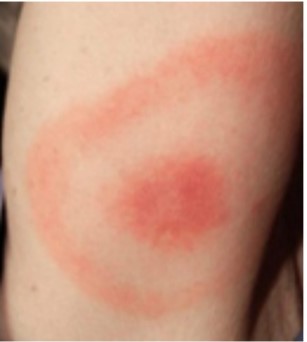Ticks and Lyme Disease
With summer comes all the joys of participating in outdoor activities such as biking, swimming, hiking and relaxing walks through woods. However with the summer comes all those annoying insects like mosquitos, black flies and ticks. In Ontario there is a growing concern regarding the increase of ticks and the potential risk to human health which comes in the form of lyme disease. Lyme disease is caused by the bacterium Borrelia burgdorferi and is transmitted to humans through the bite of infected blacklegged ticks There are about 40 diferrent species of ticks in Canada but fortunately only a few actually transmit lyme disease. Although commonly found in wooded areas, ticks can be found pretty anywhere because they are carried by the birds and other animals they feed on.
Common ticks in Canada
Deer Tick.
The official common name for a tick often suggests that it parasitizes a specific animal host (‘deer tick’, ‘dog tick’, ‘cattle tick’, etc). However, with rare exceptions, most tick species willingly suck blood from almost any animal they encounter
Western Black-Legged Tick.
The Western black-legged tick (Ixodes pacificus) is the second most common Borrelia-carrying tick in Canada. As its Latin name suggests, this tick is found mainly on the Pacific coast.
Ixodes angustus (no common name)
Although this tick’s ability to transmit Lyme disease has been debated, recent lab experiments have demonstrated that it can transmit Borrelia burgdorferi and B. bissettii. So if bitten by this tick, it’s still very important to be treated immediately
The Lone Star Tick.
Although the Lone Star Tick (Amblyomma americanum) has been shown to transmit Lyme borreliosis (Borrelia americana and Borrelia andersonii), it can transmit other infections such as Ehrlichia and Tularemia. In addition, victims bitten by the Lone Star Tick will occasionally develop a circular rash, similar to the rash of early Lyme disease. The rash may be accompanied by flu-like symptoms, and this condition has been named “Southern Tick-Associated Rash Illness” (STARI). STARI is treated with oral antibiotics. Newer research is now associating a Lone Star Tick bite to a mammalian meat allergy.
American Dog Tick.
The American Dog Tick (Dermacentor variabilis) is also a common tick in Canada, and can be found from Saskatchewan east to the Atlantic Provinces. This tick can transmit Rocky Mountain Spotted fever and Tularemia, but is not normally associated with Lyme disease
Brown Dog Tick.
The brown dog tick (Rhipicephalus sanguineus) has been shown to carry Borrelia, but their ability to transmit the bacterium to humans is still in question. The brown dog tick can transmit Rocky Mountain Spotted Fever.
Rocky Mountain Wood Tick.
The Rocky Mountain wood tick (Dermacentor andersoni) is known to transmit Rocky Mountain Spotted Fever, Tularemia, Colorado Tick Fever, and is a major cause of tick paralysis.
Symptoms of Lyme disease can be different from person to person.
Early signs and symptoms of Lyme disease usually start 3 to 30 days after you have been bitten by an infected blacklegged tick. Most people experience mild flu-like symptoms soon after being bitten, while a small number may have more serious symptoms, sometimes weeks after the bite.
Early signs and symptoms of Lyme disease may include:
Rash, sometimes shaped like a bull’s eye (Erythema migrans)
Fever
Chills
Headache
Fatigue
Muscle and joint aches
Swollen lymph nodes
If left untreated, more severe symptoms may occur and can last from months to years. Severe symptoms may include:
Severe headaches
Additional EM skin rashes
Facial paralysis (i.e. Bell’s palsy)
Intermittent muscle, joint, tendon and bone aches
Heart disorders (heart palpitations, abnormal heartbeat), known as Lyme carditis
Neurological disorders (dizziness, mental confusion or inability to think clearly, and memory loss, inflammation of the brain and spinal cord, nerve pain, numbness or tingling in the hands or feet), AND
Arthritis with severe joint pain and swelling, particularly the knees and less commonly in other joints such as the ankle, elbow and wrists.
In rare cases, Lyme disease can lead to death usually because of complications involving infection of the heart.
If diagnosed in the early stages, Lyme disease can be cured with antibiotics. Without treatment, complications involving the joints, heart, and nervous system can occur. But these symptoms are still treatable and curable
This can be extremely discouraging, to spend weeks or months on a particular antibiotic, only to figure out that it isn’t working. This is one reason that Lyme Disease is frequently treated with two different antibiotics at the same time. Another is that doubling up provides a much higher kill rate.
Even after treatment some people may experience symptoms that last months to years. This is a condition known as post-treatment Lyme disease syndrome (PTLDS).
Symptoms of PTLDS can include:
Sleep disturbance
Fatigue (tiredness)
Muscle and joint pain, and
Mental confusion or inability to think clearly, with subtle cognitive changes
Consult your health care provider right away if you develop symptoms of Lyme disease after being bitten by a tick or if you visited a known at risk area for Lyme disease. The earlier a diagnosis is made, the greater the chance of a successful treatment.
If you saved the tick that bit you, bring it to your medical appointment. Tell your doctor:
how long you estimate that the tick was attached to you
where you were when you were bitten by the tick
Public Health Ontario offers these tips for protection when out and about…
Stay on the path: if you’re in an area where ticks may be found, stay where it’s dry and avoid long grass and bushes.
Cover up: wear light coloured clothing so you can spot ticks. Long sleeves and long pants. Tuck your shirt into your pants and your pants into your socks to make it harder for ticks to find your skin.
Repellent: use an insect repellant that contains DEET.
Check: after returning home check your body for ticks, paying special attention to your scalp, ankles, armpits, groin, navel and behind your ears and knees. Also check your children and especially your pets.
Wash: take a shower or bath. Put your clothes in the dryer for at least 60 minutes to kill any ticks.
Get Health News you can use!
Sign up for our Newsletter NOW!


